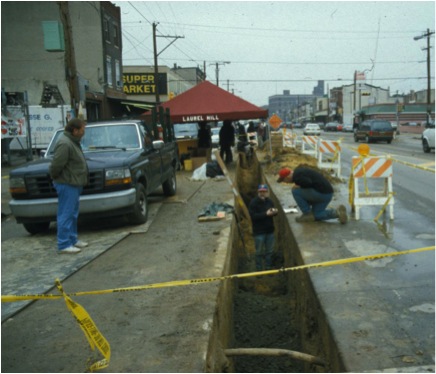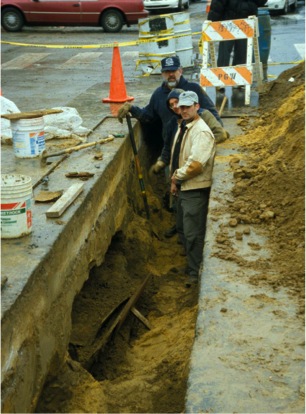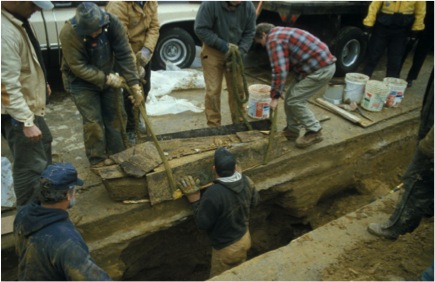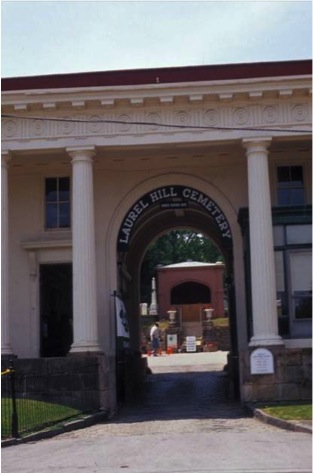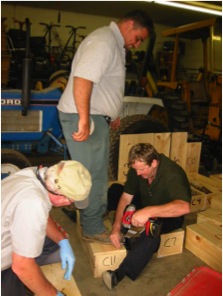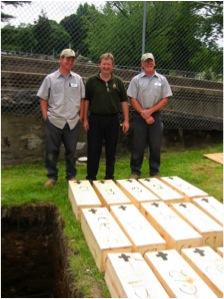The Washington Avenue Project
Back to PAF Home
Back to Project Report Index
Back to Burial Places Forum
What follows here is the text and graphics from a formal poster of the same name, presented at the 2007 Meeting of the American Association of Physical Anthropologists.
PARTNERING IN A SOUTH PHILADELPHIA DIG:
THE WASHINGTON AVENUE BIOARCHAEOLOGY PROJECT
by
A. Washburn (Department of Anatomy and Cell Biology, Temple University School of Medicine)
T.A. Crist (Program in Physical Therapy, Utica College)
M.B. Goldberg (Private practice in Philadelphia)
M. Kirkpatrick (Department of Anthropology, Temple University)
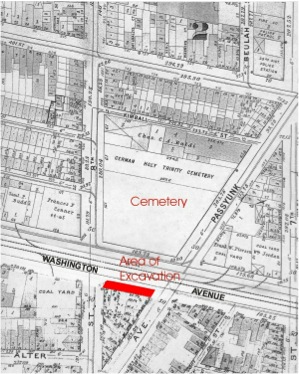
ABSTRACT
Known regionally as the birthplace of the “Philly cheesesteak”, south Philadelphia gave birth to another gem: a grassroots effort to ensure proper treatment and burial for the skeletal remains of nine adults and six children discovered during a utilities project in October 2001. Initially thought to be the remains of Civil War soldiers, the demographics and coffin design helped to put that notion to rest. The city water department, the Union League, a lawyer, the Philadelphia Orphan’s court, employees of a cemetery, a senator, a dentist, members of the Southwark Civil War Historic District Committee, faculty members and students from Temple University, a faculty member from Utica College, the Pennsylvania Funeral Director’s Association, and the General Meade Society of Philadelphia all willingly donated time and money to help excavate, curate, analyze, and eventually bury these 15 individuals in historic Laurel Hill Cemetery on Memorial Day of 2006. During the 4 years since they were exhumed from their South Philadelphia burial ground, the 15 individuals spent time in an anthropology/archaeology lab, in vaults at a cemetery in Bala Cynwyd, and then at Laurel Hill, until a decision was reached about their ultimate resting place. In the absence of local legislation providing clear guidelines for dealing with human remains encountered in these situations, the “Washington Avenue Project” is a sterling example of effective partnering among varied constituents who share a common goal and recognize the significance of these discoveries.
INTRODUCTION
Widely known for doo-wop (a cappella street harmony), boxing, steaks (“the Philly cheesesteak”), the Italian Market, and, more recently, a controversial management decision to reserve the right to deny service at a corner sandwich shop unless customers order in English, south Philadelphia, and Philadelphians in general, are often seen by outsiders as rough around the edges. Yet, in the fall of 2001, a joint venture of interested parties was undertaken that significantly raised the level of cooperation involved in a local cemetery project that can and should set the standard for future bioarchaeology projects. Known as the “Washington Avenue Project” to those involved, a diverse group of individuals saw an opportunity to work together, many without compensation, to do right by a group of former Philadelphians who were laid to rest nearly 2 centuries before their accidental discovery in October of 2001.
DISCOVERY
On October 22, 2001, along the 700 block of Washington Avenue in south Philadelphia, construction workers exposed human remains and several wooden coffins during a routine project to install a new city water line as part of a street repaving project. Work deadlines were recognized, and the city considered laying the new pipes in place over the coffins, as had been done during the original pipe installation. When Suzanne Haney, Chairperson of the Southwark Civil War Historic District Committee, learned the news and inspected the site, she believed that the remains may have been those of men who had been treated at local hospitals for wounds received during the Civil War. Since Philadelphia did not have policies and procedures for dealing with human remains unearthed in this manner, Haney initiated a “grassroots rescue” effort to buy time so that a proper exhumation and reburial of the remains might be arranged (Preservation Alliance, Winter 2002). After Haney made contact with groups with ties to Civil War history, the Philadelphia Water Department agreed to temporarily halt the pipe installation and to cover the trench with metal construction plates until decisions could be made regarding the fate of the human remains.
LEGAL MATTERS
Without legislative precedent to direct the course of events, the exhumation project became a legal tangle. Money was offered by the Union League, Laurel Hill Cemetery offered a burial plot, Temple University and Utica College provided archaeological and anthropological expertise and labor, and State Senator Vincent Fumo pledged legislative support. While there are guidelines for similar discoveries made during federally funded building and highway projects, no protocol exists for local projects. By late fall (2001), it was clear that funds necessary to conduct the exhumation would have to come from private donors, and that an Orphan’s Court order was necessary before any arrangements could be made to remove the remains. The group of interested parties grew, and fundraising appeals to Civil War preservation groups were made. By mid-January 2002, the Philadelphia Water Department announced that the pipe installation project had to go forward. The Washington Avenue “group” obtained the services (pro bono) of attorney J. Matthew Wolfe, who filed a request in Common Pleas Court for an Orphan’s Court order to require the exhumation and a Water Dept. work stoppage. The Preservation Alliance (a non-profit organization dedicated to historic preservation) agreed to act as the project’s financial agent and to manage donations designated to pay for the removal of the old pipes from over the coffins and for costs related to the exhumation.
The Court of Common Pleas of Philadelphia County, Orphan’s Court Division, issued a decree on January 18, 2002. On behalf of the petitioners, the court decreed that the remains should be dis-interred, curated and examined, and re-interred at Laurel Hill Cemetery within 60 days. In addition, archaeological and anthropological reports were required by the court.
EXCAVATION AND REMOVAL
On February 6 and 7, 2002, the Philadelphia Water Department opened the Washington Avenue trenches containing the coffins and the remains. With the help of Temple University archaeologists (Michael Stewart and Anthony Ranere) and students (Timothy Messner, Michael Owens, William Schindler, & Joe Gingerich), the Philadelphia Archaeology forum, an anthropologist (Art Washburn), Andy Waskie (civil War historian at Temple), employees of the Bringhurst Mortuary Company, and Laurel Hill Cemetery staff, the coffins were raised. Michael Stewart directed the archaeological aspect of the exhumation. Carrie Kelley and Gretchen Warden compiled field notes and drawings. Sixteen coffins were removed, including several for children. They were placed in cardboard cremation boxes donated by the Bringhurst Mortuary Company. Following exhumation, the coffins and boxes were taken by Laurel Hill Cemetery staff to the Laboratory of Anthropology at Temple University where they were opened and prepared for analysis. 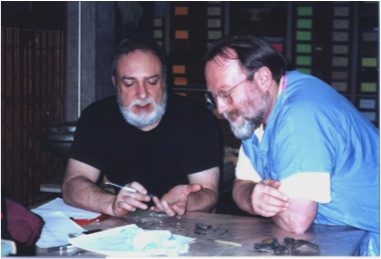
IN THE LAB
The physical anthropological analysis was a volunteer effort that involved 2 anthropologists (Art Washburn and Tom Crist) and a dentist (Myron Goldberg), each of whom examined the skeletal and dental remains. Results of this work indicated that the youngest child was a newborn and the oldest adult was a male of about 55 years of age. Archaeologists Michael Stewart and Joe Gingerich volunteered much of the archaeological expertise required to free the skeletal remains from soil that had entered the coffins and to excavate the artifacts. The analysis of the hexagonal coffins helped to date the original interments to the period between 1824 and 1850. Fabric remnants of were examined by Gary McGowan, a conservator with Cultural Preservation & Restoration of Hacketstown, NJ. Archaeological specialists with URS, Inc. of Florence, NJ examined buttons and a pipe stem. Selected tissue samples for genetic analysis were obtained by Joseph Lorenz, Jill Czarnecki and Samara Rubinstein and taken to the Coriell Institute for Medical Research in Camden, NJ. All this took place over the next few months in the laboratory under the supervision of Muriel Kirkpatrick. Andy Waskie of Temple University took the lead in the historical research and found that the remains were most likely interred in the “Bishop’s Ground”, the unofficial name for the Old St. Joseph’s Catholic Burial, much of which was moved in the early 20th century.
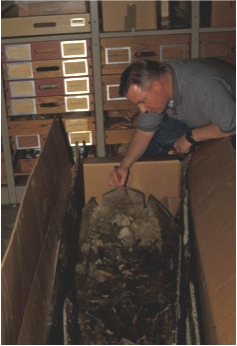
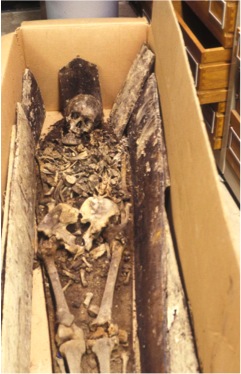
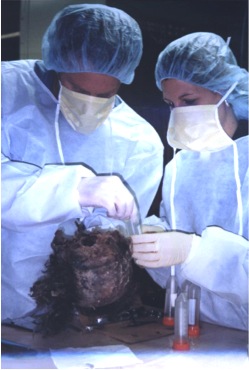
THE REST OF THE JOURNEY
During the summer of 2002 the remains were prepared for travel. The 9 adults and 6 children were transported by volunteers from Laurel Hill Cemetery to a receiving vault at West Laurel Hill Cemetery in Bala Cynwyd, PA, for interim storage. In 2004 they were taken to Laurel Hill Cemetery in Philadelphia. On Memorial Day, 2006, the remains were interred in the Valley View area of Laurel Hill Cemetery in a vault donated by Cooper Wilbert Vault Company, where they would repose in the company of some of city’s most successful business, literary, political, and military personalities. Proper respects were paid to these men, women, and children during the Memorial Day Celebration held in the cemetery commemorating Civil War Veterans of the 28th and 98th Regiments of the Pennsylvania Volunteer Infantry, reenacted by the General Meade Society of Philadelphia. At present, American flags mark their burial plot, though a plaque is planned when fundraising is completed.
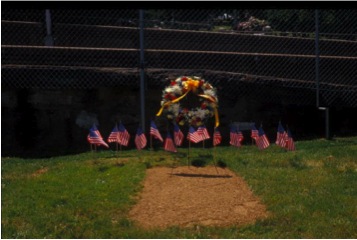
ACKNOWLEDGEMENTS
Crediting everyone for their contributions to the Washington Avenue project is not possible in the space allotted in this poster; however, this project could not have been possible without the generous support in time and effort on the part of many individuals. Special thanks goes to Laurel Hill Cemetery and friends (in particular to Ross Mitchell, Gwendolyn Kaminski, Joseph Diresco, Jr., Frank Rausch, Bill Doran, and Greg Gontz) the Bringhurst Mortuary Company, the Cooper Wilbert Vault Company, the Honorable Anne E. Lazarus (Judge, Philadelphia Orphan’s Court), the Philadelphia Water Department, J. Matthew Wolfe, Esq., students and faculty of the Department of Anthropology at Temple University, volunteer specialists with other scientific and archaeological organizations, the Preservation Alliance of Greater Philadelphia, the Philadelphia Archaeology Forum, the Union League, Andy Waskie and the General Meade Society, Ed Colimore (Philadelphia Inquirer), and Suzanne Haney. There are others, I know; you know who you are, and those of us who were intimately involved in the project thank you very much. Photos by M. Stewart, M. Kirkpatrick, M.B. Golderg, Laurel Hill Cemetary and A. Washburn.
REFERENCES
Author Unknown. Winter 2002. Grassroots Rescue for Reburial of Historical Remains Found Beneath a City Street. Preservation Alliance for Greater Philadelphia.
Bewley, J. May 29, 2006. Civil War remembrance: Honoring veterans-some here-from long ago. The Philadelphia Inquirer.
Colimore, E. March 25, 2005. Historical remains to be moved to vault: Reburial of 200-year-old bodies needs judge’s OK. The Philadelphia Inquirer.
Colimore, E. May 26, 2006. For 15 unknown souls from 1800s, a final rest. The Philadelphia Inquirer.
Dilanian, K. February 24, 2002. What to do about the historic remains that lie beneath? The Philadelphia Inquirer.
Crist, TA. 2005. Results of Physical Anthropological Examination of Undocumented Human Remains, Washington Avenue Near Seventh Street, Philadelphia, Pennsylvania. Unpublished Brief Technical Report.
Kaminski, G., editor. Summer/Fall 2006. At Rest At Last: The Burial of Washington Avenue Remains. The Laurel Hill Ledger, Laurel Hill Cemetery.
Lazarus, AE. 2002. Wash Ave Human Remains, Non Profit Corporation, Decree No. 94 NP Of 2002, Court of Common Pleas of Philadelphia County, Pennsylvania, Orphan’s Court Division.
Stewart, RM. 2005. Summary of the Archaeological Salvage of Burials, Washington Avenue, Philadelphia. Unpublished Technical Report.
___________________________________________________________
Back to Project Report Index
by admin

